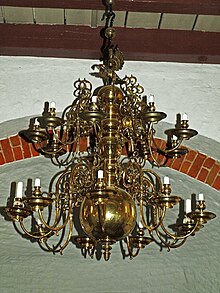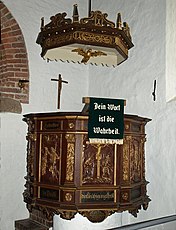St. Martin (Morsum)
The St. Martin Church is an Evangelical Lutheran church in Morsum on Sylt . It was named after St. Martin of Tours . The church stands a little away from the village on a flat hilltop in the marsh meadows. In its basic structure it is similar to the Keitum church with a retracted choir and semicircular apse . However, St. Martin has remained significantly smaller and has no towers. Like the Keitum Church, it was first mentioned in a document in 1240.
construction
The church with the retracted choir and the semicircular apse dates from the Romanesque period. The lower part of the masonry consists of granite blocks , above tuff stone was used for the choir and apse , and brick for the nave . This combination is typical of the North Frisian island churches and one can therefore assume that St. Martin was built in the last third of the 12th century, i.e. before the actual Brick Age. The nave still has the old north windows, including the three windows in the apse originally. The apse and choir are provided with diamond or stair friezes and covered with lead. The initials on the lead roof of the apse mean: HPZ (Mr. Peter Zitscher - Provost in Tondern); HOL (Mr. Otto Lorenzen - pastor in Morsum 1657–1701); HUF (Mr. Urban Flor, Pastor adjunct. 1692–1701), AO 1694. The lead roof on the south side of the choir roof was renewed in 1790 and bears the initials of Pastor Gottfried Witt and his church leaders. The lead roofing of the nave was sold in 1895 and replaced with slate. In the south a vestibule ("Kalfaster") was added in 1793, which served as a lounge for the pastor and as a sacristy . It was renewed in 1933. The sundial with the initials MLK (Martin Ludolf Krohn - pastor in Morsum 1741–1781) and KLJA on the gable dates from 1759.
Bells stack
The ringing is carried by a stack of bells that stands a little away from the church. It has four stands and an eight-sided helmet and was last renewed in 1984. In it hangs a bell with the inscription “Glori gloria in exelsis Deo 1767” and “me fecit Johann Nicolaus Bieber in Hamburg”. It will continue to be rung by hand.
Inner
The nave and choir are closed off by a wooden beam ceiling, the apse has a semi-domed vault . In front of the apse there is a round arch made of bricks, resting on warriors . The arch between the choir and the nave, which also rests on fighters, is pressed round. It was renewed in 1932. A northern gallery from 1684 was removed in the course of restoration from 1931–1933, the western gallery has been preserved. Likewise, in 1932 the rows of seats were removed from the choir, the pulpit moved to the edge and the baptismal font moved to its present location.
Furnishing
altar
The figures of the winged altar are from the late Gothic period , the case is largely new from 1933. The mercy seat is shown in the middle section . God the father does not present the risen Christ as usual, but carries his dead son in his arms (pieta), and the dove is missing. Two bishops stand to one side, St. Severin on the left , St. Martin on the right. The side wings take up the figures of the twelve apostles.
The stipes are made of tuff, the wood-carved attachment was created in 1933 by Alvin Blaue. On it you can see the tree of life with the symbols of the four evangelists .
Baptismal font
The font made from three blocks of Gotland limestone dates from the middle of the 13th century. The cup is provided with arched elements, the brass bowl dates from 1682, the baptismal jug from 1760.
pulpit
The six-sided pulpit from 1698 is made of oak and is structured by pilasters . The Annunciation , Birth of Christ , Baptism , Crucifixion , Resurrection and Ascension are shown on six relief fields . The carver of this work is counted among the circle of the Langenhorn sculptor Süncke Jensse. The five-sided sound cover from 1656 had been placed in the attic of the pastorate for decades and was only hung over the pulpit again in 2004. It is adorned with obelisks , volutes and a golden dove as a symbol of the Holy Spirit .
Holy water font
On the left side of the choir there is a more than 1000 year old holy water basin , which was carved from two granite blocks and is decorated with four crosses. Until he returned to the church in 1932, it had been used as a rain catcher. There is a grave plaque on the wall above the holy water font, commemorating the death of 50 Morsum sailors in the storm surge on March 15, 1744
chandelier
The brass chandelier in the nave with two wreaths of light is based on an old model from Denmark from 1979. In the chancel there is a Flemish chandelier from 1713 with the inscription: “Johann Pietersen de Haen / Engel Jansen de Haen / Anno 1713 in honor of God and the churches of Zirath / Worshiped this crown. ”The two founders, brothers of Lorenz de Haen, were whaling captains and thanked God for their healthy return home. it has two wreaths of light and is crowned by a pelican. Which, according to legend, heals and feeds his youngsters with his blood and thus became a symbolic bird for Jesus.
painting
Two pastor pictures show the pastors Flor Senior († 1739) and Junior († 1759) in half a figure. Another painting shows the Last Supper. The picture is the lost central part of an old altar in the church and was rediscovered in 1999 during the restoration of the current altar, as the back wall of which it served. The painting is set in a gable-like frame and is flanked by two winding columns, it hangs on the north wall of the choir room.
window
The three openings in the apse windows, which were closed in the meantime, were broken open again in 1932/1933, the window pictures were redesigned according to designs by the Flensburg artist Käte Lassen .
organ
The company Kemper in Lübeck built the organ with twelve registers 1965. 1973 it was by Eberhard Tolle from Preetz new intones, in 1984 by the Kiel organ builder Rudolf Neuthor restored and expanded since then has 22 speaking stops in major work , Rückpositiv and pedal , added come three paddocks .
|
|
|
|||||||||||||||||||||||||||||||||||||||||||||||||
- Coupling: II / I, I / P, II / P
literature
- Art topography Schleswig-Holstein. Neumünster 1982, ISBN 3-529-02627-1 .
- DuMont art travel guide Schleswig-Holstein. Cologne 1989, ISBN 3-7701-0936-8 .
- Dirk Jonkanski, Lutz Wilde : Village churches in Schleswig-Holstein. Neumünster 2000, ISBN 3-529-02845-2 .
- Quick art guide. No. 1702: Saint Martin Morsum. Pastor Jochim Hartung, ISBN 3-7954-5411-5 .
Individual evidence
Web links
Coordinates: 54 ° 52 ′ 4.2 " N , 8 ° 25 ′ 58.2" E











